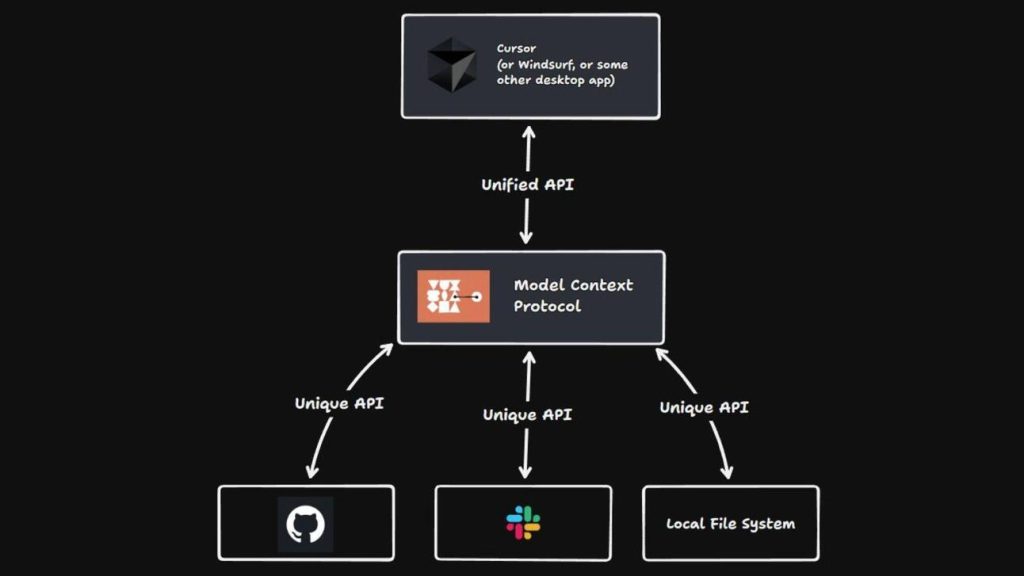Decoding the Power and Potential of Model Context Protocol

The AI landscape is buzzing with the mention of Model Context Protocol, or MCP. This tool, although not new, is gaining popularity. It promises to redefine how AI agents interact with third-party apps. But what exactly makes MCP so special?
MCP fever showcases a paradigm shift in AI, offering solutions where communication between diverse applications was once stunted. By acting as a universal translator, MCP aims to enhance AI agent capabilities significantly. Join us as we explore how this advanced protocol stands to impact the AI realm and its practical implications.
What is Model Context Protocol?
Model Context Protocol has recently become a buzzword in AI conversations. It’s a set of instructions designed by Anthropic for large language models (LLMs) to interact efficiently with third-party applications. Although released last November, the protocol is currently trending as developers recognize its power.
Before MCP, trying to make LLMs understand and communicate with external apps felt like trying to make two different languages resonate without a translator. The absence of a bridge often led to complications for many developers. Now, thanks to MCP, this barrier is diminishing effortlessly.
MCP’s Revolutionary Potential
MCP’s underlining advantage lies in its ability to serve as a universal translator, eliminating the need for exclusive integrations. Its impact is already evident as programmers slowly adopt it, realizing its time-saving qualities.
Santiago Valdarrama, a computer scientist, claims MCP could make AI agents 100 times more powerful. The protocol not only simplifies processes but also slashes coding complexity involved in integration tasks, creating seamless communication across platforms.
The Adoption Journey of MCP
Adopting MCP isn’t a walk in the park, though.
Building an MCP server requires both skill and patience. For those eager to dive in, various tutorials provide a roadmap to successfully harness its utility, offering a blend of straightforward and comprehensive guidance.
Many developers, however, face hurdles. Critics like Theo Brown argue that as AI agents become more sophisticated, the need for such middle-men like MCP might fade. While MCP has its strengths, developers must consider the dynamic nature of AI technology and evolving needs.
Recent AI Developments and Trends
AI advancements are on the horizon.
Meta’s Llama 4, set for release soon, promises to merge voice and agents, making user interactions more intuitive. Meanwhile, Microsoft’s new MAI model competes with established players like OpenAI. These developments highlight the rapidly changing AI landscape.
Beyond model competition, there’s a buzz about AI tools that promise productivity boosts. Whether it’s AI in presentations or query resolution, the blend of innovation and efficiency is captivating. The AI world is ever-evolving, filled with promising changes and exciting possibilities.
Critiques and Challenges
Not everyone is convinced about MCP’s long-term benefits. Some developers argue that bugs present significant challenges. As AI evolves, these middle-man protocols might become obsolete, leading to debates about its future relevance.
As software becomes more autonomous, the reliance on protocols like MCP may decrease. While the current capabilities are impressive, only time will affirm whether MCP will hold its ground or evolve with the tech scene.
Ensuring a harmonious transition during AI evolution is key. Even as critics voice concerns, MCP stands firm, compelling the AI industry to reassess its trajectory and potential.
Influence and Application of MCP
MCP is revolutionizing more than just tech integrations. Its influence extends to productivity tools, redesigning workflows by offering better interaction between AI and user applications.
In practice, adopting MCP means smoother operations, faster processing times, and more intuitive technologies. Its potential to revolutionize industries through enhanced AI interactions makes it a significant player in modern development.
Redefining task efficiency, MCP aligns with the modern pace of technological demands, offering promising pathways to tech advancement and growth.
Microsoft and Meta Insights
Microsoft’s ongoing development with their Copilot AI assistant shows strategic divergence from earlier partnerships with OpenAI.
The new model, MAI, is crafted to match or exceed contemporary AI capabilities, indicating a focus shift in Microsoft’s strategy. Concurrently, Meta embarks on their frontier journey with Llama 4. These developments showcase strategic maneuvering in the AI space amidst growing market competition.
Despite competitive rivalries, these brands focus on innovation and collaborative advancements, leaving room for anticipation and exploration in the AI sector.
AI Product Launch Strategies
Launching a new AI product demands a comprehensive strategy.
Utilizing AI agents like ARI from You.com offers a strategic approach to product launches. Through a sequence of detailed steps, companies can refine their messaging and optimize multi-channel strategies effortlessly.
Product launches backed by AI insights can propel business success. As companies navigate competitive landscapes, integrating AI helps in crafting effective go-to-market strategies.
The Future Impact of MCP
Looking ahead, MCP stands as a beacon for evolving AI technologies.
Its role as an interaction facilitator might streamline processes across industries, offering unprecedented integration solutions. As the technology landscape continues to evolve, MCP’s legacy will depend on its adaptability and sustained relevance.
Flexibility, adaptability, and practicality will define MCP’s influence, as the AI world watches and learns from unfolding changes.
MCP presents a transformative approach to AI integration. It bridges gaps where once there were chasms. As industries embrace this tool, it signals a shift towards seamless AI interactions, potentially redefining our digital landscape. The journey of MCP is just beginning, promising an inspired vision for the future.






